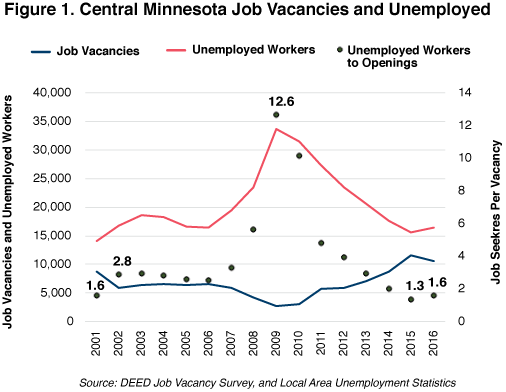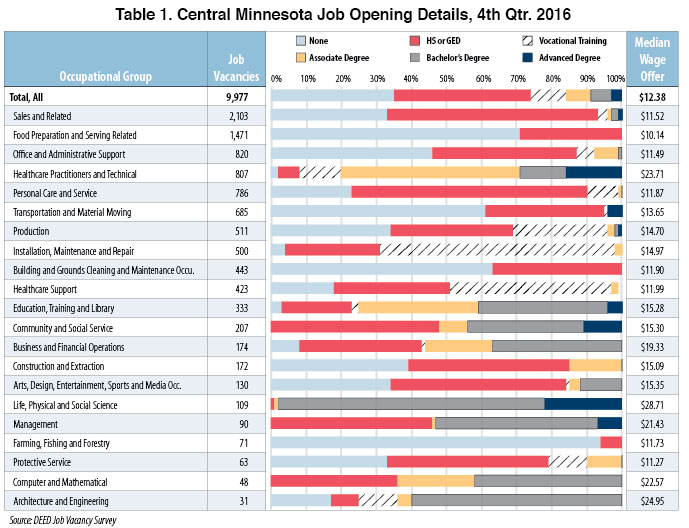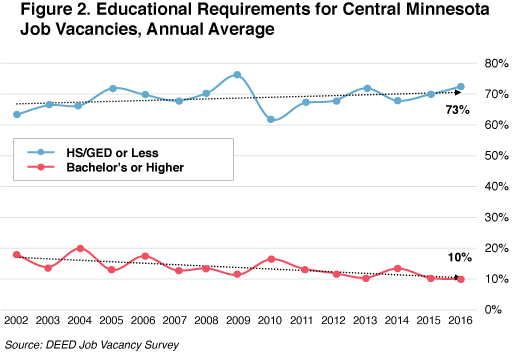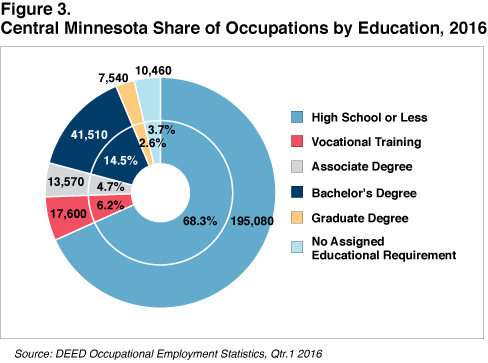
by Luke Greiner
June 2017
Job vacancies in Central Minnesota were nearly 60 percent higher than average last year.
Central Minnesota businesses are searching for workers, which is good news for job seekers but creates challenges for employers. With just under 273,000 jobs reported in both the second and third quarters of 2016, Central Minnesota reached a new employment peak this year. The region has the most jobs of any region in Greater Minnesota.
Employment, however, slowed from 1.8 percent growth through the first three quarters of 2015 to just 0.8 percent growth in 2016 – and it’s not clear why. One plausible explanation is employers are finding it increasingly difficult to fill job vacancies.
Job vacancy data seem to support this explanation, with employers posting about 10,000 job openings in the fourth quarter of 2016, the fifth-largest number dating back to 2001. In fact, four of the five highest vacancy counts have been posted in the past two years, with last year’s count nearly 60 percent higher than the average over the past 16 years.
Even more telling is the ratio of unemployed job seekers to available job vacancies. Prior to the recession, Central Minnesota had nearly three unemployed workers for every job opening. But as the recession took hold, layoffs coupled with decreasing job vacancies increased the ratio to nearly 13 job seekers per vacancy. By last year, however, job seekers per job opening had dropped to just 1.6 in the region (see Figure 1).

For job seekers, the tight labor market allows greater job mobility and leverage to negotiate compensation packages. The openings require a variety of education levels, so job seekers have a good mix of options.
Overall, just 26 percent of openings in Central Minnesota required postsecondary education in the fourth quarter of 2016, while another 25 percent required a certificate or license. Like elsewhere in Minnesota, the occupations with the most openings were primarily low-wage retail sales jobs and food and beverage positions. Combined, those two occupations accounted for 23.5 percent of all openings in the region, higher than the 17.1 percent statewide.
Despite the large number of jobs in those two occupations, not all openings are for low-wage jobs. In fact, Central Minnesota had 1,400 openings in occupations that had median wage offers of $16 per hour or more. The majority of occupations with high starting wages require postsecondary education. Many of them were licensed health care positions. There were a number of occupations, however, with lower educational requirements that have median starting wages above $16 per hour.
Education is similar to other job requirements, in the sense that it is highly dependent on the specific type of occupation. Table 1 illustrates the different educational requirements for jobs. For instance, 92 percent of health care practitioner openings require postsecondary education, while no openings for occupations in food preparation and serving, building and grounds cleaning and maintenance, and farming require higher education.

Occupational groups that typically have a high share of openings requiring a bachelor’s degree still have opportunities for high school graduates. For instance, 43 percent of business and financial operations job vacancies required no more than a high school diploma, as well as 36 percent of computer and mathematical vacancies. With 74 percent of job openings requiring nothing more than a high school diploma, nearly every type of occupational category has openings with low educational barriers.
Overall, just 10 percent of all openings required vocational training. Associate degrees were required for 7 percent of the openings in Central Minnesota in the fourth quarter of 2016, but over half (51 percent) of health care practitioner and technical occupation vacancies required an associate degree. Many of these postings were for registered nurses and medical technicians.
While many job seekers set their sights on attaining a bachelor’s degree, just 6 percent of openings in Central Minnesota required a bachelor’s in 2016. Another 3 percent of openings required an advanced degree. Vacancies with a high likelihood of requiring a bachelor’s degree were focused in life, physical and social science (76 percent), architecture and engineering (60 percent) and management (46 percent).
Interestingly, the share of job vacancies in Central Minnesota requiring higher education has remained mostly constant since at least 2002. If anything, the trend appears to be toward an increasing share of vacancies that require a high school diploma or less (see Figure 2).

In fact, a higher proportion of vacancies required a high school diploma or less in the last three years of the survey than in the first three years (from 2002 to 2004). An important nuance is that even though the share of jobs requiring a bachelor’s degree or more has declined slightly, the actual number of jobs requiring a bachelor’s degree or more has increased in recent years. Since job vacancies are at record levels, the number requiring a high school diploma or less also has increased.
Another important nuance is that median wage offers tend to increase for occupations with higher educational requirements and for jobs requiring prior work experience. Although it is difficult to measure the value of experience over education, many job postings require a certain level of education or equivalent experience.
Occupations requiring vocational training or an associate degree accounted for 10.9 percent of total employment (31,170 jobs) in the region last year. Just over 17 percent of jobs required a bachelor’s or graduate degree (49,050 jobs). Another 3.7 percent (10,460 jobs) had no consistent educational requirement (see Figure 3).

These educational requirements can be instructive for Central Minnesota institutions that are training people for jobs.
Occupations requiring a high school diploma often require basic skills such as communication, accountability, teamwork and problem-solving. Occupations that require vocational training or an associate degree often depend on technical and community colleges or apprenticeship programs to provide the skills necessary, in addition to what is learned in high school. Occupations with the highest educational requirements depend on universities to offer relevant programs of study.
Each type of educational institution is important for Central Minnesota’s economy to thrive and grow. In the grand scheme, learning isn’t complete after graduating from high school or college. Rather, continual learning on the job is necessary to achieve success. There are opportunities for workers of every educational background in the region to find good-paying jobs. Limited educational attainment doesn’t necessarily limit income potential.
Understanding the quantity and quality of occupations by the amount of education needed can help guide the way the region addresses its already tight labor market. Educational and workforce data can guide resources, advise policy and inform a new generation of workers about opportunities in Central Minnesota (see Table 2).
| Highest Paying Occupations in Central Minnesota With Significant Employment by Educational Requirement, 2016 | |||||||
|---|---|---|---|---|---|---|---|
| Educational Requirement | Occupation | Estimated Employment | Median Wage | Educational Requirement | Occupation | Estimated Employment | Median Wage |
| High School Diploma or Less | Electrical Power-Line Installers and Repairers | 730 | $81,682 | Bachelor's Degree | Chief Executives | 750 | $139,518 |
| Supervisors/Managers of Construction Workers | 660 | $68,039 | Medical and Health Services Managers | 670 | $93,295 | ||
| Loan Officers | 710 | $63,614 | Financial Managers | 870 | $90,690 | ||
| Supervisors/Managers of Mechanics, Installers and Repairers | 990 | $63,243 | Sales Managers | 950 | $88,330 | ||
| Sales Reps, Wholesale and Manufacturing, Except Technical/Scientific Products | 3,090 | $58,147 | Administrative Services Managers | 520 | $87,811 | ||
| Vocational Training | Electricians | 1,180 | $54,386 | Graduate Degree | Pharmacists | 560 | $133,197 |
| Industrial Machinery Mechanics | 760 | $48,419 | Education Administrators, Elementary and Secondary School | 480 | $104,650 | ||
| Machinists | 1,720 | $47,749 | Physical Therapists | 450 | $81,338 | ||
| Licensed Practical and Licensed Vocational Nurses | 2,870 | $41,215 | Lawyers | 510 | $69,360 | ||
| Automotive Service Technicians and Mechanics | 1,770 | $35,572 | Child, Family and School Social Workers | 730 | $53,372 | ||
| Associate Degree | Registered Nurses | 7,120 | $75,522 | No Clear Educational Requirement | Managers, All Other | 780 | $91,639 |
| Radiologic Technologists and Technicians | 440 | $61,719 | Business Operations Specialists, All Other | 1,260 | $54,289 | ||
| Police and Sheriff's Patrol Officers | 1,210 | $53,586 | Sales Representatives, Services, All Other | 1,360 | $48,528 | ||
| Medical and Clinical Laboratory Technicians | 440 | $44,938 | Education, Training and Library Workers, All Other | 420 | $39,729 | ||
| Computer User Support Specialists | 950 | $42,282 | Community and Social Service Specialists, All Other | 500 | $39,699 | ||
| Source: DEED Occupational Employment Statistics and Educational Requirements | |||||||